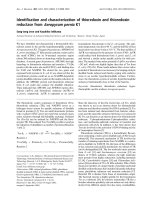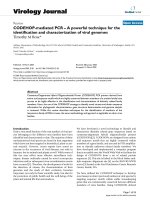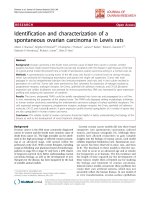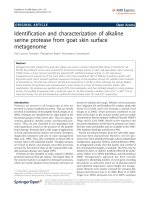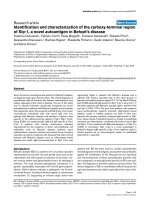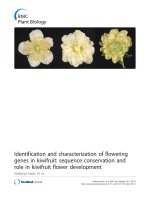Identification and characterization of a purple nonsulfur bacterium isolated from coastal area of Hai Phong for using in production of unsaturated fatty acid (OMEGA 6, 7, 9)
Bạn đang xem bản rút gọn của tài liệu. Xem và tải ngay bản đầy đủ của tài liệu tại đây (417.77 KB, 12 trang )
Vietnam Journal of Science and Technology 57 (6) (2019) 665-676
doi:10.15625/2525-2518/57/6/13711
IDENTIFICATION AND CHARACTERIZATION OF A PURPLE
NONSULFUR BACTERIUM ISOLATED FROM COASTAL AREA
OF HAI PHONG FOR USING IN PRODUCTION OF
UNSATURATED FATTY ACID (OMEGA 6, 7, 9)
Hoang Thi Yen1, *, Tran Thi Thu Quynh1, Chu Hoang Ha1, Do Thi Tuyen1,
Dang Tat Thanh2, Dinh Thi Thu Hang3
1
Institute of Biotechnology, Vietnam Academy of Science and Technology,
18 Hoang Quoc Viet Road, Cau Giay District, Ha Noi
2
Department of Science and Technology, Ministry of Industry and Trade,
54 Hai Ba Trung Road, Hoan Kiem District, Ha Noi
3
Graduate University of Sciences and Technology, VAST, 18 Hoang Quoc Viet Road,
Cau Giay District, Ha Noi
*
Email:
Received: 27 March 2019; Accepted for publication: 1 October 2019
Abstract. Purple nonsulfur bacteria are a group of diverse biotechnological applications,
particularly in producing functional food rich in unsaturated fatty acids. In this study, a purple
nonsulfur bacterium strain HPB.6 was chosen based on its strong growth, high lipid production
and synthesis of unsaturated fatty acid (omega 6, 7, 9). The studying on biological characteristics
showed that strain HPB.6 comprises ovoid-rod shaped cells with diameter of 0.8 - 1.0 µm, none
motile, Gram negative stained. The cells divide by binary fission and contain
bacteriochlorophyll a (Bchl a). This bacterium grew well on medium with carbon and nitrogen
sources such as acetate, succinate, pyruvate, butyrate, glutamate, arginine, leucine, tyrosine,
alanine, methionine, threonine, glutamine, yeast extract and NH4Cl. This selected strain grew
well on medium with salt concentrations from 1.5 - 6.0 % (optimum 3 %), pH from 5.0 to 8.0
(optimum at pH 6.5) and could withstand Na2S at 0.4 - 5.2 mM. All the data and particularly 16S
rRNA analysis received demonstrated that HPB.6 strain belongs to the species Rhodovulum
sulfidophilum.
Keywords: Rhodovulum sulfidophilum, PNSB, characterization, identification, omega.
Classification numbers: 1.3.2, 1.4.1, 2.7.1.
1. INTRODUCTION
Purple nonsulfur bacteria (PNSB) are either alpha or beta-proteobacteria that are able to
carry out photosynthesis without oxygen production such as cyanobacteria, algae and green
plants [1]. Under micro aerobic conditions in the light, all species grow as photoheterotrophs
with various organic substrates or as photoautotrophs with either molecular hydrogen or in some
Hoang T. Yen, Tran T. Thu Quynh, Chu H. Ha, Do T. Tuyen, Dang Tat Thanh, Dinh T. Thu Hang
species, sulfide, thiosulfate or elemental sulfur as electron donor and CO2 as sole carbon sources
[2].
Purple nonsulfur bacteria are the most diverse and most useful group among all anoxygenic
phototrophic bacteria for various biotechnological applications such as production of single cell
protein (SCP); production of valuable compounds (vitamin, ubiquinone, carotenoid, hormones,
enzymes, etc.) and for wastewater treatment [3] and functional food formation [4].
Functional foods rich in unsaturated fatty acids (omega 6, 7, 9), especially omega 7
(palmitoleic acid and vaccenic acid), are beneficial to human health. Health supporting function
such as antioxidant, anti-inflammatory, immune system modulator, strengthens the
cardiovascular system and mucous membrane tissue regenerator have been proven [5]. Beside
that vaccenic acid can prevent coronary heart disease [6], atherosclerosis [7] and inhibited
growth of HT-29 cell [8]. Omega 6, 9 are abundant in animal and vegetable oils but omega 7 is
rare. It is extracted from sea buckthorn berries and macadamia oil [9]. Omega 7 (vaccenic acid)
is discovered in the cell of PNSB with high rate (65-82 % of total fatty acids) [10].
From 25 strains of purple nonsulfur bacteria isolated from mud and waste water samples
collected at Haiphong coastal area in Vietnam, a strain named HPB.6 was selected depended on
criteria as performing best growth, highest lipid synthesis and especially synthesizing
unsaturated fatty acid (omega 6, 7, 9). In order to use this strain for extracting unsaturated fatty
acid (omega 6, 7, 9) and for other biotechnological applications, characterization and
identification of the strain is reported.
2. MATERIALS AND METHODS
2.1. Cultivation of purple nonsulfur bacteria
Growth of HPB.6 was determined by cell density at 660 nm (ΔOD660) after 4 days of
culture in DSMZ-27 medium [11] under micro aerobic conditions (cultivated in 13 ml tube
contained 10 ml medium) with intensity illuminate about 5.000 lux, the temperature was 28 30 ºC. The DSMZ-27 (pH 7.0) contains the following components per liter of distilled water: 0.3
g yeast extract; 0.5 ml ethanol; 1 g succinate; 0.5 g acetate; 5 ml ferric citrate from 0.1 % (w/v)
stock; 0.5 g KH2PO4; 0.4 g MgSO4 .7H2O; 0.05 g CaCl2. 2H2O; 0.4 g NH4Cl; 25 g NaCl; trace
element solution SL6; and 1 ml vitamin B12 solution (filter sterilized). Trace element solution
SL6 contains (l-1) 1.8 g FeCl2.4H2O; 0.25 g CoCl2.6H2O; 0.01 g NiCl.6H2O; 0.01 g CuCl2.5H2O,
0.07 g MnCl2.4H2O; 0.1 g ZnCl2; 0.5 g H3BO3; 0.01 g Na2SiO3.5H2O; 0.03 g Na2MoO4.2H2O.
Vitamin B12 solution was added after autoclaving.
2.2. Analysis of photosynthesis pigments
To determine the presence of photosynthetic pigments such as bacteriochlorophyll a and b
(Bchl a, Bchl b), the whole cell suspensions spectra were recorded using UV-Vis spectroscopy
within a range of 380-1.000 nm [12]. In this range, Bchl a with absorption peak at 800-900 nm
wide spread and Bchl b with absorption peak at 1000-1030 nm.
2.3. Morphological characterization
The pigmentation of the PNSB ranges from brown, red to red-purple (Munsell Color
®
Chart ). The cell size and shape was determined using optical microscope OLYMPUS Model
666
Characterization and identification of a purple nonsulfur bacteria isolated from coastal area of…
CH-S (Japan) and Scanning Electron Microscopy (SEM) JEOL-5410LV (Japan).
2.4. Physiological characterization
Carbon and nitrogen requirement
Strain HPB.6 was cultivated in DSMZ-27 medium in micro aerobic conditions with
intensity illuminate about 5.000 lux, the temperature was 28 - 30 ºC. In the experiment with
different carbon sources, to the DSMZ-27 medium without organic carbon different carbon
sources were added (1 g/l). In the experiment with nitrogen sources, to the DSMZ-27 medium
without nitrogen, different defined nitrogen sources were added (10 mM), and the undefined
nitrogen sources such as yeast extract, was added at 1 g/l.
Effect of sulfide and NaCl on the growth
Strain HPB.6 was cultured in liquid DSMZ-27 medium containing Na2S (from 0 to 5.2
mM) and NaCl (0 - 10 %) in micro aerobic conditions, at temperature: 28 - 30 ºC, intensity
illuminate: 5.000 lux.
Effect of initial pH on the growth
Strain HPB.6 was cultured in liquid DSMZ-27 medium with pH range from 4.5 - 10 and
incubated under micro aerobic conditions with intensity illuminate about 5.000 lux, the
temperature was about 28 – 30 ºC.
2.5. Molecular analysis
HPB.6 strain was cultured on DSMZ-27 at temperature 28 – 30 oC, illumination intensity
about 5.000 lux at micro aerobic condition. After the cultivation of 4 days, the biomass was
harvested by centrifugation at 8.000 r/min for DNA isolation. Genomic DNA was extracted and
purified by using Gene JET Genomic DNA Purification Kit (Thermo). Taq DNA polymerase
with standard Taq Buffer (NEB) was used for PCR. The complete length of the 16S rRNA gene
sequence
was
obtained
by
amplification
with
two
primers,
F1
(5’AGAGTTTGATCCTGGCTCAG-3’), and R1 (5’-ACGGCTACCTTGTTACGACT-3’) [Positions
8–27 and 1491–1512 for F1 and R1 respectively [13]. PCR amplification was performed
following Imhoff [14,15] and 16S rRNA gene sequencing was performed on 3130xl Applied
Biosystems ABI prism automated DNA sequencer [16].
2.6. Phylogenetic tree construction
The 16S rRNA gene sequence of strain HPB.6 was determined on relatedness to reference
type strain sequences in the Gen Bank database using the BLASTn program. Sequence was
aligned with reference type strain (GenBank database) using MUSCLE alignment tool.
Phylogenetic tree was constructed using the maximum likelihood method and Tamura-Nei
model [17]. Evolutionary analyses were conducted in MEGA X [18].
3. RESULTS AND DISCUSSION
3.1. Determination of bacteriochlorophyll
667
Hoang T. Yen, Tran T. Thu Quynh, Chu H. Ha, Do T. Tuyen, Dang Tat Thanh, Dinh T. Thu Hang
A typical characteristic of PNSB is bacteriochlorophyll containing in the cell. For its
determination was used UV-VIS spectroscopic analysis indicated that absorption peaks were
from 380-900 nm. In this range, the maximum peaks absorption of bacteriochlorophyll signals
were at 802 and 853 nm. This result strongly demonstrated that HPB.6 cell contains Bch a (Fig. 1).
853
Absorbance
802
Wavelength (nm)
Figure 1. Whole absorption spectrum of strain HPB.6.
3.2. Morphological characteristics
Strain HPB.6 forms brown colonies with diameter of 2.3-2.7 mm on agar DSMZ-27
medium after one-week cultivation (Fig. 2a). Under scanning electron microscope (SEM), the
cells were observed as ovoid-rod shape and the diameter of a single bacterium was about 0.8-1.0
µm, none motile, Gram negative bacterium, cells divided by binary fission (Fig. 2b).
Figure 2. Morphological characteristics of strain HPB.6 (a) –The colonies under optical microscope;
(b) – Cells under scanning electronic microscope (20.000 ×).
3.3. Physiological characteristics
3.3.1. Carbon and nitrogen requirement
For determination of carbon and nitrogen sources requirement for growth, strain HPB.6
was cultivated in liquid organic carbon/nitrogen free DSMZ - 27 medium, and incubated with
light (5.000 lux) under limited oxygen condition (by cover with tube cap). Growth after 4 days
incubation was accessed as cell density (OD600), the obtained result was showed in Table 1.
668
Characterization and identification of a purple nonsulfur bacteria isolated from coastal area of…
Table 1. Carbon and nitrogen requirement for growth of HPB.6 in modified DSMZ-27 medium.
Carbon and nitrogen compounds
Carbon sources
Nitrogen sources
Acetate
Succinate
Pyruvate
Formate
Propionate
Butyrate
Malate
Lactate
Citrate
Glutamate
Glucose
HPB.6
+++
+++
+++
++
++
+++
++
++
+++
+
Fructose
Glycerol
++
Benzoate
Ethanol
Arginine
Leucine
Tyrosine
Alanine
Methionine
Threonine
Glutamine
Phenylanine
Lysine
KNO3
Urea
NH4Cl
Yeast extracted
+++
+++
+++
+++
+++
+++
+++
++
++
++
+++
+++
Note: Increased cell density at 660 nm after the incubation of 4 days (-): ΔOD660 < 0.1 - no growth;
(+): ΔOD660 from 0.1 - 0.5 - weak growth; (++): ΔOD660, from 0.5 to 1.0 - normal growth;
(+++): ΔOD660 > 1.0 - strong growth
Data in Table 1 showed that strain HPB.6 used almost all tested carbon and nitrogen
sources. The strain grew strongly on carbon sources such as acetate, succinate, pyruvate,
butyrate, glutamate; normally on the media containing formate, propionate, malate, lactate,
glycerol and weakly on media containing glucose and no growth in media containing citrate,
fructose, benzoate and ethanol. While strain HPB.6 grew best on arginine, leucine, tyrosine,
alanine, methionine, threonine, glutamine, yeast extracted and NH4Cl; it grew normally in the
media containing phenylanine, KNO3, urea and none growth in the media containing lysine.
The above obtained data indicated that strain HPB.6 was capable of using a variety of
carbon and nitrogen sources for growth. This is also common characteristic of PNSBs, giving
them ability to exist in a variety of environments with different conditions [1].
669
Hoang T. Yen, Tran T. Thu Quynh, Chu H. Ha, Do T. Tuyen, Dang Tat Thanh, Dinh T. Thu Hang
Among PNSBs, species of the genus Rhodovulum have several phenotypic properties
resemble to species of the genus Rhodobacter. The characteristics of strain HPB.6 obtained in
this study, including colony and cell morphology, bacteriochlorophyll content, the pattern of
carbon and nitrogen sources for growth indicated that the strain might belong either to the genus
Rhodobacter or Rhodovulum [1]. The only difference between these two genera is salt dependent
growth i.e. Rhodobacter spp are slight halophiles, whereas Rhodovulum spp. are stimulated by
salt and are considered as moderate halophiles [1]. Therefore, investigation of salt-dependent
growth of strain HPB.6 would give hint of identification at genus level.
3.3.2. Effect of salt (NaCl) concentration on growth
Strain HPB.6 was cultivated in liquid DSMZ-27 medium containing NaCl at concentrations
of 0 – 10 % and incubated under micro aerobic conditions with intensity illuminate was about
5.000 lux, the temperature was about 28 - 30 ºC. The growth after 4 days, expressed as cell
density at 600 nm (ΔOD660) (Fig. 3) showed that salt stimulated growth of this strain. HPB.6
strain grew better in medium contained salt concentration range from 1.5 to 6.0 % and the
optimum salt concentration was 3.0 % (ΔOD660 reached 1.785). At the salt concentration of more
than 8.0 % and at no salt concentration, the growth of this bacterium was decreased (ΔOD660
reached 1.023 and 0.914 respectively). This result suggested that strain HPB.6 belonged to the
genus Rhodovulum.
For determination which species HPB.6 strain may be belong to Rhodovulum genus, the
effect of pH and sulfide on its growth was conducted.
2.0
ΔOD660
1.6
1.2
0.8
0.4
0.0
1
2
3
4
5
6
7
8
9 10
NaCl concentration (%)
11
12
13
14
15
Figure 3. Growth of HPB.6 strain in liquid DSMZ-27 medium contained different NaCl concentration.
3.3.3. Effect of pH
In order to determine the pH effect on growth, HPB.6 was cultured on liquid DSMZ-27
medium with pH range from 4.5 - 10, at microaerobic conditions, illumination intensity about
5.000 lux, temperature 28 – 30 °C. After the cultivation of 4 days (96 h), the biomass
accumulation (ΔOD660) of the studied strains was determined, the results were shown in Fig. 4.
670
Characterization and identification of a purple nonsulfur bacteria isolated from coastal area of…
2
∆OD660
1.6
1.2
0.8
0.4
0
4.5
5
5.5
6
6.5
7
7.5
pH
8
8.5
9
9.5
10
Figure 4. Effect of pH on growth of HPB.6 strain.
Figure 4 indicated the strain grew at a wide range of pH from 5.0 to 8.0 (optimum at pH
6.5). At the current time, the genus Rhodovulum comprises 20 published species in which 3
species named Rhodovulum marinum, Rhodovulum sulfidophilum (old name was
Rhodopseudomonas sulfidophila) and Rhodovulum mangrovi can grow well on acidic medium
(pH 5.0) [19-21]. Beside that Rhodovulum visakhapatnamense species can be tolerated in
medium with pH 4.0 [22]. From the effect of pH on growth of the HPB.6 strain suggested that
the strain may be one of these species.
3.3.4. Effect of sulfide
Strain was cultured on DSMZ-27 containing Na2S at different concentrations (0 to 5.2 mM)
under micro aerobic conditions. The biomass accumulation (ΔOD660) after the cultivation of 4
days showed in Fig. 5.
Figure 5 showed that the strain could withstand Na2S at 0.4 - 5.2 mM. The genus
Rhodovulum have 3 species named R. sulfidophilum; R. lacipuncei and R. aestuarii can be
tolerated high sulfide (from 4.0 to 7.0 mM) [20, 23, 24]. From result the ability of using sulfide,
HPB.6 strain may belong to one of the three species as above mentioned.
2.0
∆OD660
1.6
1.2
0.8
0.4
0.0
0
0.4
0.8
1.2
1.6
2
2.4 2.8 3.2 3.6
Na2S concentration (mM)
4
4.4
4.8
5.2
Figure 5. Effect of Na2S on growth of HPB.6 strain.
671
Hoang T. Yen, Tran T. Thu Quynh, Chu H. Ha, Do T. Tuyen, Dang Tat Thanh, Dinh T. Thu Hang
Combination of tolerated acidic pH and Na2S property, demonstrated HPB.6 may belong to
R. sulfidophilum. The comparison of some basic characteristics of HPB.6 species with R.
sulfidophilum (Hansen W4T) was described in Table 2.
Table 2. Differential characteristics between strain HPB.6 and type strains of closely related
species of the genus Rhodovulum.
Characteristic
R. sulfidophilum (HansenW4T)
0.6-1.0
Ovoid – rod
+
+
Brown
A
0-10
5.0 - 9.0
5.2 - 8.0
Cell diameter (m)
Cell shape
Motility
Negative staining
Color of cell suspension
Bacteriochlorophyll
NaCl range (%) (optimum)
pH range (optimum)
Sulfide tolerance (mM)
HPB.6
0.8 - 1.0
Ovoid - rod
+
+
Brown
a
0-9 (3)
5.0 - 8.0 (6.5)
4.0 - 5.2
Carbon sources utilization
Acetate
Succinate
Pyruvate
Formate
Propionate
+
+
+
+
+
+
+
+
+
+
Carbon sources utilization
Butyrate
Malate
Lactate
Citrate
Glutamate
Glucose
Fructose
Glycerol
Benzoate
Ethanol
+
+
+
+
+
+
-
+
+
+
+
+
+
-
(-): no growth; (+): growth
Table 2 showed that HPB.6 strain had almost biological characteristic nearly the same R.
sulfidophilum (Hansen W4T) species. However, in order to make more accurate conclusions the
16S rRNA gene sequences of the strain was analyzed.
3.4. 16S rRNA gene analysis
After extracting by using GeneJET Genomic DNA purification Kit, genomic DNA was
tested on 1 % agarose gel and the result was showed in Fig. 6. Duplication of the 16S rRNA
672
Characterization and identification of a purple nonsulfur bacteria isolated from coastal area of…
genome by PCR using Taq DNA polymerase and the 16S primer (shown in materials and
methods). The PCR product was tested on 1 % agarose gel in TAE buffer and results was
showed in Fig. 7.
M
1
M
1
2
10.0 kb
1.5 kb
1.0 kb
1.5 kb
Figure 6. Agarose gel electrophoresis.
Lane M - 1kb DNA molecular weight markers;
Lane 1 - genomic DNA of HPB.6.
Figure 7. Agarose gel electrophoresis.
Lane M -1kb DNA molecular weight markers
Lane 1 - negative control, Lane 2 - PCR product of
HPB.6.
Figure 8. Phylogenetic tree of HPB.6 strain.
After sequencing, the 16S rRNA sequence were submitted to GenBank to obtain accession
numbers MN172416. The sequence showed 99,7 % similarity with R. sulfidophilum Hansen W4T
(D16423) in genbank. The phylogenetic analysis was done to compare the 16S rRNA gene
673
Hoang T. Yen, Tran T. Thu Quynh, Chu H. Ha, Do T. Tuyen, Dang Tat Thanh, Dinh T. Thu Hang
sequences of HPB.6 with sequences of other members of the genus Rhodovulum and their
relatives that belong to the genus Rhodobacter, Rhodoplanes, Rhodopseudomonas,
Rhodospirillum, Roseospira (Fig. 8).
The phylogenetic tree showed that the Rhodovulum and Rhodobacter genus were separated
into two distinct branches. Strain HPB.6 was in the same branch of the genus Rhodovulum and
shared a high bootstrap value of 99 % with Rhodovulum sulfidophilum Hansen W4T (D16423).
The result showed that they can conveniently be grouped as the same species.
The HPB.6 strain was found to be closely related to the species R. sulfidophilum based on
morphology, physiological properties and phylogenetic analysis of HPB.6 strain using 16S
rRNA gene sequence data accordingly confirmed HPB.6 belongs to Rhodovulum sulfidophilum.
4. CONCLUSIONS
In this paper, identification and characterization of a PNSB (named HPB.6) isolated from
coastal of Haiphong producing unsaturated fatty acid (omega 6, 7, 9) were reported. The result
of morphological study showed that the cells of HPB.6 were observed as ovoid-rod shape, none
motility, Gram negative staining. The diameter of single bacterium was about 0.8 - 1.0 µm. The
cells divide by binary fission and has bacteriochlorophyll a (Bchla). The physiological
characterization indicated that this bacterium grew well on medium rich in carbon and nitrogen
sources, salt concentrations from 1.5 - 6.0 % (optimum 3 %), pH from 5.0 to 8.0 (optimum at pH
6.5) and could particularly stand Na2S at 0.4 - 5.2 mM.
Based on morphological, physiological properties and 16SrRNA analysis, the HPB.6 was
identified as belongs to Rhodovulum sulfidophilum and it opens the possibilities to use this strain
for biomass and important fatty acid (omega 6, 7, 9) production.
Acknowledgements. The research funding from National Project of Biotechnology development and
application in processing industry to 2020 supported by Ministry of Industry and Trade (Grant number:
09/HĐ-ĐT.09.17/CNSHCB) was acknowledged.
REFERENCES
1.
Imhoff J. F., Hiraishi A., and Suling J. - Anoxygenic phototrophic purple bacteria,
Bergey’s manual of Systematic Bacteriology 2 (2005) 1-41.
2.
Imhoff J. F., and Truper H. G. - Purple non-sulfur bacteria, Bergey’s manual of
Systematic Bacteriology, Williams and Wilkins, Baltimore 3 (1989) 1658-1680.
3.
Sasikala C. and Ramana C.V. - Biotechnological potentials of photosynthetic bacteria I:
Production of single cell protein, vitamins, ubiquinone, hormones, and enzymes and use in
waste treatment, Adv Appl Microbiol. 41 (1995) 173-225.
4.
Kim D. H., Lee J. H., Hwang, Y., Kang, S., and Kim M. S. - Continuous Cultivation of
Photosynthetic Bacteria for Fatty Acids Production, Bioresource Technology 148 (2013)
277-282.
5.
Song I. B., Gu H., Han H. J., Lee N. Y., Cha J. Y., Son Y. K., and Kwon J. - Effects of 7MEGATM 500 on Oxidative Stress, Inflammation, and Skin Regeneration in H2O2-Treated
Skin Cells, Toxicological Research 34 (2018) 103-110.
674
Characterization and identification of a purple nonsulfur bacteria isolated from coastal area of…
6.
Luc D., Nirupa R. M., Alice H. L., John M. G. - Red blood cell membrane concentration
of cis-palmitoleic and cis-vaccenic acids and risk of coronary heart disease, Am. J.
Cardiol. 110 (4) (2012) 539-44.
7.
Abbas A., Ali M., Gholamreza B., Kamran M., Sajad S. - The Effect of Cis and Trans
Vaccenic Acids on Expression of ICAM-1 And VCAM-1 in Human Microvascular
Endothelial Cells (HMEC), JRPS 4 (1) (2015) 65-74.
8.
Atif B. A., Tracy H., Carol S. F., Peter J. H. - 18:1 n7 fatty acids inhibit growth and
decrease inositol phosphate release in HT-29 cells compared to n9 fatty acids, Cancer
Letters 91 (1995) 55-61.
9.
Maria E. F. and Ruth G. A. - The role of the novel lipokine palmitoleic acid in health and
disease, Adv. Nutr. 8 (1) (2017) 173S-181S.
10. Harley J.P., Prescott L.M - Laboratory Exercises in Microbiology, 7th Edition, Mc GrawHill, (2007).
11. (2007).
12. Madigan M. T., Martinko J. M. and Parker J. - Brock Biology of Microoganism, 10th ed,
New Jersey: Pearson Education, (2007).
13. Devereux R., Willis S. G. - Amplification of ribosomal RNA sequences, Molecular
Microbial Ecology Manual (Akkermans A D L, van Elsas J D, de Bruijn F J, eds.),
Kluwer, Dordrecht, 3.3.1 (1995) 1–11.
14. Imhoff J. F. and Pfennig N. - Thioflavicoccus mobilis gen. nov., sp. nov., a novel purple
sulfur bacterium with bacteriochlorophyll b, Int. J. Syst. Evol. Microbiol. 51 (2001) 105110.
15. Imhoff J. F., Suling J. and Petri R. - Phylogenetic relationships among the Chromatiaceae,
their taxonomic reclassification and description of the new genera Thiocapsa,
Halochromatium, Isochromatium, Marichromatium, Thiococcus, Thiohalocapsa and
Thermochromatium, Int. J. Syst. 48 (1998) 1129-1143.
16. Subhash Y., Sasikala Ch. and Ramana Ch. V. - Flavobacterium aquaticum sp. nov.,
isolated from a water sample of a rice field, Int. J. Syst. Evol. Microbiol. 63 (2013) 3463–
3469.
17. Tamura K., Nei M. - Estimation of the number of nucleotide substitutions in the control
region of mitochondrial DNA in humans and chimpanzees, Molecular Biology and
Evolution 10 (1993) 512-526.
18. Kumar S., Stecher G., Li M., Knyaz C., Tamura K. - MEGA X: Molecular Evolutionary
Genetics Analysis across computing platforms, Molecular Biology and Evolution 35
(2018) 1547-1549.
19. Srinivas T. N. R., Anil K. P., Sasikala Ch., Ramana Ch. V., Su¨ ling J. and Imhoff J. F. Rhodovulum marinum sp. nov., a new phototrophic purple non-sulfur
alphaproteobacterium from marine tides of Visakhapatnam, Int. J. Syst. Evol. Microbiol.
56 (2006) 1651–1656.
20. Hansen T. A. and Veldkamp H. - Rhodopseudomonas sulfidophila, nov. spec., a new
species of the purple non-sulfur bacteria, Arch. Microbiol. 92 (1973) 45–58.
675
Hoang T. Yen, Tran T. Thu Quynh, Chu H. Ha, Do T. Tuyen, Dang Tat Thanh, Dinh T. Thu Hang
21. Nupur T. N. R., Srinivas S. T and Kumar P. A. - Rhodovulum mangrovi sp. nov., a
phototrophic alphaproteobacterium isolated from a mangrove forest sediment sample, Int.
J. Syst. Evol. Microbiol. 64 (2014) 3168–3173.
22. Srinivas T. N. R., Anil K. P., Sasikala Ch., Ramana Ch. and Imhoff J. F. - Rhodovulum
visakhapatnamense sp. nov, Int. J. Syst .Evol. Microbiol. 57 (2007) 1762–1764.
23. Chakravarthy S. K., Sucharitha K., Sasikala Ch. and Ramana Ch. V. - Rhodovulum
lacipunicei sp. nov., an obligate sulfide-demanding phototrophic alphaproteobacterium
isolated from a purple pond in India, Int. J. Syst. Evol .Microbiol. 59 (2009) 1615–1619.
24. Divyasree B., Lakshmi K. V. N. S., Bharti P. Dave, Sasikala Ch. and Ramana Ch. V. Rhodovulum aestuarii sp. nov., isolated from a brackish water body, Int. J. Syst. Evol.
Microbiol. 66 (2016) 165–171.
676
